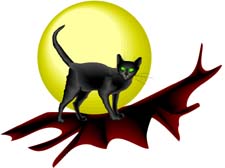Origins of Halloween
 Halloween is not only a colourful night of fun, frights, sweets and costumes. It is a full-blown industry, with more than $14 billion spent each year on costumes, decorations, party supplies, candy and other paraphernalia.
Halloween is not only a colourful night of fun, frights, sweets and costumes. It is a full-blown industry, with more than $14 billion spent each year on costumes, decorations, party supplies, candy and other paraphernalia.How did it all get started?
The origins of Halloween are quite dark, and go all the way back to 2,000 years ago, to the Celtic Celebration of the Dead, or Samhain (Sah-ween), in what is now Ireland, the UK, and Northern France. The Celtic Festival took place each year on the eve of November first, which marked the end of summer and harvest season, and the beginning of their New Year and winter, a time associated with cold and death. Samhain festivities lasted for a couple of days, until about November 2nd.
The Celts believed that on October 31st, the last day of summer and New Year’s Eve, the boundaries between the living and the dead became blurred and thin, and spirits, both good and evil, roamed about on the streets and countryside and did as they wished. The Celts were especially frightened by the prospect of these evil souls harming the crops.
On this night, Celtic priests called Druids dressed in animal masks and skins and performed sacrifices to placate the gods and “ward off” spirits. Bonfires represented the sun, the power to fight dark forces. The Druids lit huge bonfires and burned animals, crops, and sometimes even humans. In fact, the word “bonfire” comes from “bonefire,” literally! (It’s interesting to note that the practice of burning humans continued as late as the 1600s).
Besides the Druids, people also performed their little “rituals.” To ward off spirits, they carved turnips and lit them with embers. To “fool” them, they wore animal masks or scary disguises. To placate them, they left fruits and nuts at their doorstep as a gift or offering, thus preventing future bad crops. This is the origin of “Trick or Treat.”
Around the 7th Century the Celebration of the Dead spread to Europe, but it became known as “All Hollows Eve,” or “Night of the Dead.” In parts of Britain and Ireland it also became known as “Mischief Night.”
Around the 800s the Christians moved to the Celtic lands and tried to eradicate all pagan beliefs and celebrations. In an attempt to placate the Celts, Pope Boniface IV designated November first as All Saints Day as an attempt to replace the pagan “All Hollows Eve.” Thus he “transformed” the Celebration of the Dead into a Christian holy day.
It is believed that later the Irish brought the tradition of carving turnips to America. However, they soon found out that there weren’t as many turnips there, and that pumpkins were a lot bigger and better to carve scary faces on.
Eventually “All Hollows Eve” came to be known as Halloween.
The traditional Halloween symbols we know today, like witches, black cats, ghosts, pumpkins and candles appeared in the US around the 1800s. Entrepreneur minds no doubt realized the marketing potential. The whole concept of Halloween gradually became commercialized.
Today, in spite of its dark origins and although some religious people consider it an “evil” festival, Halloween is mostly regarded as a spooky yet harmless, fun, family celebration.
©2005, 2007, 2009, 2010. Mayra Calvani / All Rights Reserved. This column may not be copied nor printed in any form without permission from the author.

Comments
~Carla
www.jollyjansen.blogspot.com
http://HoustonParentsMagazine.com